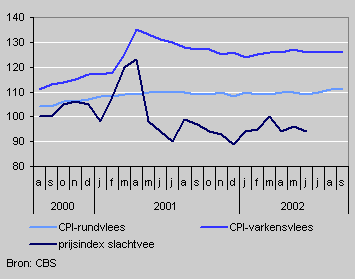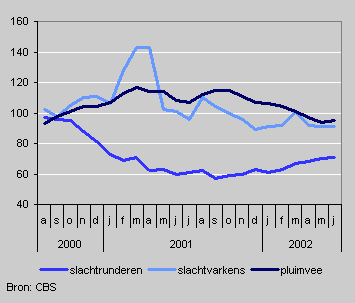Meat prices: consumers paying more, farmers getting less

Consumer price index
In its press announcement of 5 August 2003 Statistics Netherlands reported that the figures for the period June 2002 to June 2003 are incorrect. Therefore the CPI figures in this publication are incorrect.
The press release of 9 September contains the corrected figures for the series for all households, and for the harmonised consumer price index.
Consumers have been having to pay more and more for meat in recent years, particularly for pork.
Livestock prices, on the other hand, have fallen substantially. While farmers could expect to receive 700 euro for a beef cow in September 2000, exactly one year later they had to make do with only 350 euro.
Price index figures for meat (1995=100)

Consumers paying more, low prices for farmers
In the first three quarters of 2002 consumers paid an average 17 percent more for their meat than in 1995. Pork prices rose by just over 25 percent, beef prices by about ten percent.
Price index figures for a number of categories of meat livestock (1995=100)

A farmer selling a cow to be slaughtered for meat, however, received forty percent less in the first half of 2002 than on average in 1995.
Price recovered since foot-and-mouth crisis
Immediately after the foot-and-mouth outbreak the price for poultry and pigs bred for meat rose strongly. Pig farmers were able to benefit from for a few months.
Since then the price indices for beef cattle, porkers and poultry have been converging again, although the differences are still substantial. Beef cattle prices in July 2002, for example, were thirty percent under the 1995 average. Prices for poultry and pigs were five and ten percent lower than in 1995.
Cor Pierik